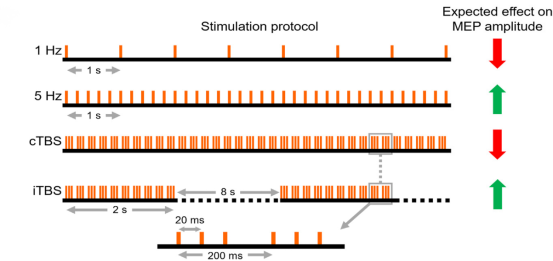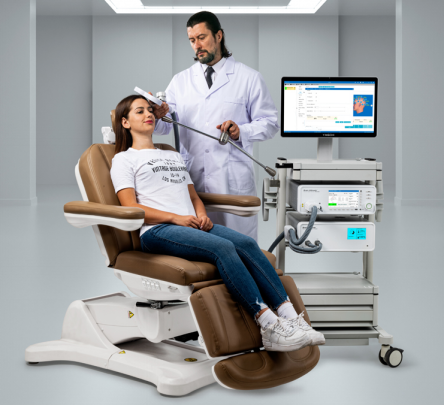Release time :2022-10-21
Source:support@yingchitech.com
Scan:2172
TMS stands for Transcranial Magnetic Stimulation. It is an electromagnetic induction therapy that uses magnetic fields for stimulating nerves in the brain. The principle behind this therapy is that when a magnetic field passes through a coil, an electrical current will be produced in the coil, which can stimulate nerves in your brain or other organs in your body. This therapy has been used to treat depression and other mental disorders since 2005. Each treatment session lasts 30 minutes and consists of 30 pulses per second at a 1 Hz frequency (so 30 pulses per second).
rTMS is an acronym for Repetitive Transcranial Magnetic Stimulation, which refers to applying recurring TMS pulses to a specific brain region. rTMS has been studied as a potential treatment for several psychiatric and neurological disorders. It's also used to help study the brain. More importantly, rTMS can be used to treat depression, obsessive-compulsive disorder (OCD), and other mental health conditions.
The neuromodulatory effects depend upon several stimulation parameters such as frequency, intensity, duration, cortical target, number of sessions, and patient factors such as age, disease state, medication trial, and individual symptoms. Broadly, rTMS(repetitive transcranial magnetic stimulation) has been classified as high frequency(>1 Hz), which increases the cortical excitability, and low frequency(<1 Hz), which depresses the cortical excitability.[1]

Goldsworthy, M. R., Hordacre, B., Rothwell, J. C., & Ridding, M. C. (2021). Effects of rTMS on the brain: is there value in variability? Cortex, 139, 43–59.
rTMS(repetitive transcranial magnetic stimulation) influences electrical brain activity through a pulsed magnetic field. This magnetic field is created by passing quick current pulses through a coil of wire. The coil of wire is encased in plastic and placed close to a client’s scalp in order for the magnetic field to be focused on particular areas of the brain. The magnetic field can safely penetrate the scalp and scull without pain, to create a current in targeted brain cells. Because this stimulation is given at regular intervals it is referred to as repetitive TMS, or rTMS.
This is a noninvasive procedure that usually takes between 30 and 60 minutesTrusted Source to perform.

The therapeutic potentials for rTMS have been demonstrated for the following[1]:
Transcranial magnetic stimulation is a unique stimulation protocol that has been used for both diagnostic and therapeutic purposes. It can be administered using three protocols:
Although rTMS is a non-invasive technique and its side effect profile is rare, but it may induce seizures. Hence, it is not recommended for patients with epilepsy. Pre-existing neurological disease, adolescents, change in medication regime, substance use during the rTMS course (especially during HF-rTMS)should also be taken into account as they dlower the seizure threshold. It is, therefore, necessary that services, where rTMS is being provided, should be well equipped to deal with any seizure episode in patients.[4]
repetitive transcranial magnetic stimulation) is relatively a well tolerable treatment but may present with pain at the stimulation site, posttreatment headaches, neck pain, or toothache. Muscle twitching during treatment can also occur. Transient changes in the auditory threshold, hyperacusis, have been demonstrated due to the loud clicks produced during TMS pulse. Hence, hearing protection is mandatory. Metallic/electronic implants or cochlear implants that are in close contact with the TMS coil serve as an absolute contraindication.[4][5]
[1] Mann SK, Malhi NK. Repetitive Transcranial Magnetic Stimulation. [Updated 2022 Mar 9]. In: StatPearls [Internet]. Treasure Island (FL): StatPearls Publishing; 2022 Jan-. Available from: https://www.ncbi.nlm.nih.gov/books/NBK568715/
[2] Medically Reviewed by Dan Brennan, MD on June 29, 2021. Available from: https://www.webmd.com/depression/repetitive-transcranial-magnetic-stimulation
[3] Medically reviewed by Timothy J. Legg, PhD, PsyD — By Rachel Nall, MSN, CRNA — Updated on June 30, 2020. Available from: https://www.healthline.com/health/depression/repetitive-transcranial-magnetic-stimulation#uses
[4] Lefaucheur JP. Transcranial magnetic stimulation. Handb Clin Neurol. 2019;160:559-580.
[5] Taylor R, Galvez V, Loo C. Transcranial magnetic stimulation (TMS) safety: a practical guide for psychiatrists. Australas Psychiatry. 2018 Apr;26(2):189-192.
[6] Damar U, Lee Kaye H, Smith NA, Pennell PB, Rotenberg A. Safety and Tolerability of Repetitive Transcranial Magnetic Stimulation During Pregnancy: A Case Report and Literature Review. J Clin Neurophysiol. 2020 Mar;37(2):164-169.
[7] Goldsworthy, M. R., Hordacre, B., Rothwell, J. C., & Ridding, M. C. (2021). Effects of rTMS on the brain: is there value in variability? Cortex, 139, 43–59.